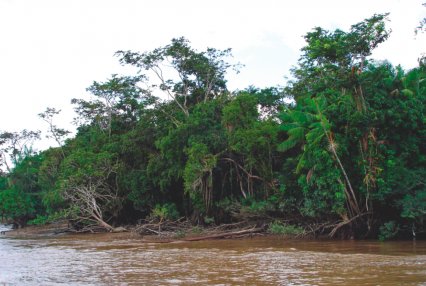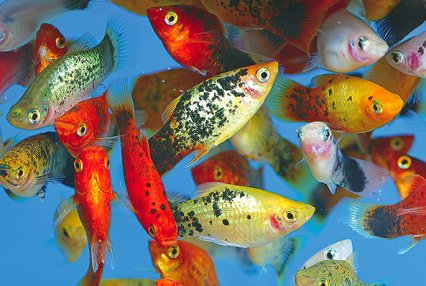Most community tanks tend to be a mix of fish from around the world, often from wildly different habitats. Nathan Hill explains how to create four attractive biotope correct community tank set-ups for compatible fish from specific areas of the world's waterways.
Few of us start at the ultra-specialised end of the hobby— and our first introduction to fishkeeping will probably be the 'community' aquarium.
The word 'community' is vague, suggesting a tank in which fish are neither hostile nor predate on each other and also share similarities that enable them to live in harmony.
All introductory books on fishkeeping will have some section dedicated to community set-ups and their suitable inhabitants, but few authors are challenging the old traditions.
The traditional community can be far from ideal for the fish included within it. Livestock will often be mixed from across the globe where water qualities differ and conditions can be wild opposites. In many cases, even with temperature it can be difficult to find a happy medium.
Sometimes, a geographically more accurate community tank can be easy to achieve, after a little reading up and discussions with your local fish experts.
If new to the hobby you’ll probably want to do exactly as I did and pick and mix fish from tanks all over to create an array of colours. If so — stop right there!
Grab a cup of tea, take an extraten minutes out to continue reading this and hopefully we’ll find something that might be better for your fish, but just as attractive, colour-wise.

The key areas
When it comes to collecting and exporting fish for the tropical hobby, few areas outshine any of the others.
Firstly there’s South America, so rich in choice of tetra and characins, armoured and suckermouthed catfish, colourful cichlids and knifefish.
Then we have magical Africa, offering ranges of different cichlids, eels, killifish, bagrid and clariid catfish, pufferfish, mormyrids and cyprinids.
Next, we see huge quantities of barbs, danios, rasbora, stream catfish, loaches and anabantids — or labyrinthfish — coming in from South-East Asia.
Another large influence is Central America, although, for community purposes, this is linked with the livebearers such as guppies, platies and mollies. However, many are also found further south and have been introduced almost worldwide.
Then, smaller but increasingly popular, Australia and New Guinea offers a selection of attractive rainbowfishes that are now streaming in.
Here I’ll be exploring potential communities made up from four of these areas and offering a templated guide for each.
Although there are similarities between many regions, there are also some big differences.
Water quality — the levels of ammonia, nitrite and nitrate — should be consistently low with whichever fish we choose to house, but tinkering with water chemistry — the pH and hardness of the water — could prove more troublesome.
Initial steps
Test the water early on. Find out what conditions you have and work your fish choice around those results. It’s much easier to do this than forever trying to alter the chemistry of your tank. Whatever conditions you have there will be something to fit in with them perfectly.
The quality of life of our fish is affected by more than just water conditions. How they interact with tank mates also plays a crucial role in their wellbeing. Making sure that fish are compatible socially is vital in minimising any risk of bullying or feeling threatened.
Shop wisely
Creating a region-specific community can be easy and fun. Some stores even make things extra simple by keeping the fish from different regions together in one system — and, of course, such an exercise is exactly the reason why fish shops are manned by experts!
Some fish to avoid
I suspect there will be 'old favourites' as described in books that you’ll possibly want to work around, but some have shown that, over time, they’re not best suited to communities of any kinds. These should definitely be off your list.

Barbs
These get a lot of bad press nowadays and most of it is undeserved — but a few should still be left well alone.
Tiger barbs are the main reason for barb anxiety. Some are notorious nippers, especially when kept in smaller numbers. They’re always going to be a gamble and attractive alternatives are many.
Tinfoil barbs are often seen, too. These are lovely but grow huge, more than 30cm/12”, and will dominate all but the largest tanks.

Sharks
Freshwater sharks are not really sharks, but part of the cyprinid family – closer to barbs than Great whites. However, going by their temperament, you’d struggle to tell the difference. The Red-tailed shark in particular seems to be a menace, growing to 15cm/6” and ever ready to turn on its tank mates. They’re quick to take over and difficult to re-home.

Catfish
The classic catfish offered as community safe is the Common plec (Liposarcus spp.) which, although peaceful and sold to 'clean' the tank, will grow to more than 30cm/12” and require re-housing. It’s a shame, as there are so many miniature alternatives better suited.
Another beautiful culprit is the Pictus catfish (Pimelodus pictus). This fish is predatory and will delight on snacking on any fish it can fit into its cavernous mouth.

Oddballs
Consistently featured in older literature is a selection of fish that turn out to be quite unsuited to anything but the most specialised tanks. Anything unusual should be researched thoroughly before considering any purchases, but the general rule is that very few oddballs are suited to normal aquaria.
Knifefish, especially the Black ghost knife (Apteronotus albinifrons), are shy, nocturnal fish that grow large and eat smaller tank mates.
Elephant noses are less frequently seen in stores nowadays, but our understanding now shows that they require very specific foods and substrates, as well as quieter tanks with subdued light.
Choose your region
Far from exact but better than a wordwide medley, here are four different global regions for you to try at home. All of the fish I have suggested here can be found with some shopping around, but with a little reading up on the subject, you’ll soon be making lists of your own. Enjoy!

African community
This is good for softer, slightly acidic water, pH riding between 6.8 and 7.2, but moderately forgiving.
The lighting offered can be slightly subdued, as the plants are more robust, and fine gravel may be better than sand, given that most plants will be on wood rather than in substrate.
Temperature should be somewhere around 25-27°C/77-81°F and we want high oxygen levels, so don’t be afraid to position filters to break the water’s surface and turn them to maximum flow.
Your décor should consist of larger, rounded stone and pieces of bogwood or African driftwood.
Plants
What's hot
- Anubias of all species tied to the wood, but also alone in gravel if necessary.
- African ferns, Bolbitis heudelotti for the back and sides.
- Floating plants, Water hyacinth being good.
What's not
- Any red-leaved plants.
- Micranthemum.
- Red leaved Ludwigia.
- Hydrocotyle.
- African Aponogeton species.

Fish
What's hot
- Pelvicachromis or Nanochromis species.
- African tetra.
- Eutropiellus catfish.
- Microsynodontis.
- Smaller African barbs.
- Killifish are colourful but short lived. Some require more acidic water.
- Butterfly fish, provided there’s nothing small enough for them to eat.
What's not
- Mormyrids, especially elephant-nosed fish.
- Eels.
- Any fish from lakes Malawi or Tanganyika.
- African pufferfish.
- Bichirs will consume tank mates.
- Mouthbrooder cichlids or Tilapia species.
- Jewel cichlids.

Asian medley
Ranges of conditions are tolerated, with slight shifts into acid water being normal, ideally aiming at a pH of 6.5-7.0.Water is best soft and temperature can be kept quite high at 26-29°C/79-84°F. Lighting wants to be moderate, but not scalding.
Some areas of South-East Asia are more acidic than others, so we’re looking to find a happy medium in this set-up.
Planting can be generous and most fish will appreciate it. Provide many hiding places for the more nervous fish.
Sand is preferred, but fine gravel will be OK for some of the plants.
Liberal use of wood, with plants attached, is the way forward!
Plants
What's hot
- Java fern tied to wood.
- Cryptocoryne.
- Vallisneria grasses.
- Non-red Hygrophila.
- Limnophila aquatica for dense bushiness.
- Java moss, for timid fish to hide in.
What's not
- Amazon swords.
- Anubias.
- Any red-leaved plants.
- Micranthemum.
- Red leaved Ludwigia.
- Hydrocotyle.
- Bolbitis heudelotii.
- African Aponogeton species.

Fish
What's hot
- Torpedo-shaped barbs, such as Cherries.
- Danios.
- Croaking or Sparkling gourami.
- Smaller loaches, such as Kuhli loach.
- Glass catfish.
- Rasbora.
What's not
- Pangasius cats, as these grow huge.
- Asian climbing perch, the ambush predators.
- Long-finned Betta.
- Tiger barbs.
- Larger loaches, such as Clown loach.
- Nipping loaches, such as Skunk loaches.

Classic South American
Ideal for those with very soft and acidic tapwater and the best pH is between 6.5-7.0. Aim for a temperature of 25-26°C/77-79°F, and increase lighting if possible for abundant plant growth.
Try to purchase sand in preference to gravel for the base if you want those plants to thrive.
For best effect, heavily plant with two or three species. You may need to get an entry level CO2 unit to keep things happy at a later date, but the results will be well worth it, with fish hiding among dense leaves.
Lots of bogwood would be a good décor feature, in combination with occasional rounded pebbles.
Plants
What's hot
- Any Echinodorus.
- Myriophyllum sp.
- Hydrocotyle will make an interesting and unusual centrepiece.
- Alternanthera reineckii for those with stronger lights, providing a nice break within the green.
- Floating plants.
What's not
- Java fern.
- Anubias.
- Cryptocoryne fare better in tanks without intense light.
- Hygrophila species.
- Rotala species.
- Any Hemigraphis species.

Fish
What's hot
- Torpedo-shaped tetra.
- Any short-snouted Corydoras.
- Otocinclus, smaller Ancistrus, Peckoltia.
- Hatchetfish.
- Pencilfish.
- Dwarf cichlids, but not too many.
- Endler’s guppy.
What's not
- Non-dwarf cichlids.
- Silver dollars.
- Deeper-bodied tetra, as some can bite.
- Pimelodid catfish.
- Common or Sailfin plec.
- Knifefish.
- Biting pufferfish.

Central American livebearer
By far the easiest tank to create, and best suited to those that have neutral to alkaline water, pH 7.0-8.2.
Hardness can be moderately high, with some fish verging on a brackish existence.
If lighting can be intense then have it; the plants will love it. Temperature can be from 23-28°C/73-82°F, but strong water flow is not essential here.
Opt for large, rounded stones for your décor, although wood can still be used.
The fish will enjoy grazing on algae that forms on rocks.
Fine gravel may be a preferable choice than sand, due to the limited demands of some plants.
Plants
What's hot
- Cabomba, used liberally.
- Bacopa caroliniana creates hiding places.
- Ludwigia repens will introduce colour.
- Hemianthus micranthemoides, as this dense little plant will provide cover for fry.
What's not
- Most Amazon swords, but not all.
- Java fern.
- Anubias.
- Cryptocoryne.
- Riccia, which will be grazed to bits.
- Limnophila, sometimes confused with Cabomba.

Fish
What's hot
- Platies, either Xiphophorus variatus or maculatus.
- Swordtails, mollies, but be wary of Black mollies that may require salt added.
- Gambusia mosquitofish.
- Guppies of all varieties.
What's not
- Most cichlids, especially Convict cichlids and Jack Dempseys.
- Arius shark catfish, as these are brackish.
- Anableps four-eyed fish.
- Mexican cave fish are nice but too nippy.
Why not take out a subscription to Practical Fishkeeping magazine? See our latest subscription offer.







